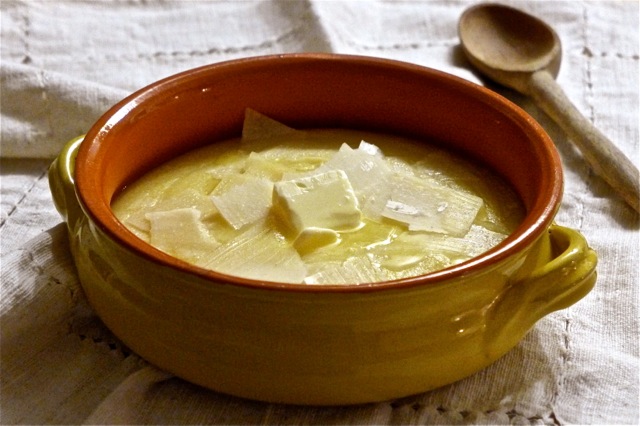
Mini-stirred polenta, served loose with butter and shaved grand padano cheese. | Credit: Nathan Hoyt
Nearly twenty-five years ago I wrote an article for Cook’s magazine titled “Polenta: To Stir With Love.” In it, I advocated the traditional method for stirring the cornmeal and water continually as it simmers on the stove for lump-free and silky results, just as I had watched my mother and countless cooks in Italy’s polenta-loving regions do. Although most cornmeal package directions call for simmering it for some 45 minutes, many Italian cooks believe that it should be cooked for at least an hour or even longer, to improve its creaminess and render it more digestible. (Where the stirring was once done by hand, today, electrical polenta makers, commonplace in home and restaurant kitchens alike throughout Italy, do the job.)
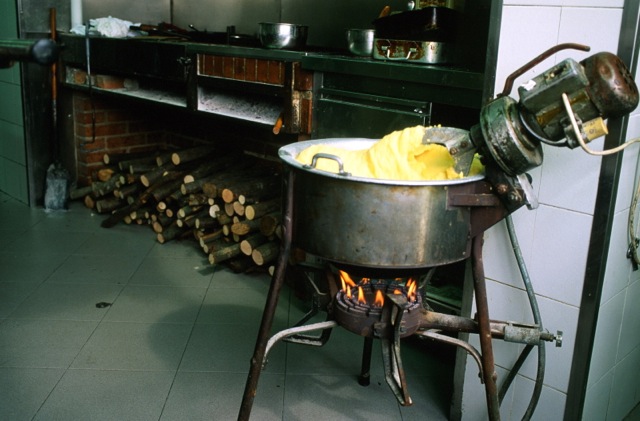
The traditional stirring method for making polenta. Electric polenta “paiolo” (cauldron) at Trattoria Antico Fattore, Florence. | Credit: Paolo Destefanis, www.paolodestefanis.com

The hallowed grain, celebrated at a street festival, the Sagra della Polenta, Borgo Tossignano (Bologna). | Credit: Emilia-Romagna Turismo
For the Italians of Veneto, Lombardy, Valle D’Aosta, Friuli, Friuli-Venezia Giulia, and parts of Piemonte, who have relied on polenta as a mainstay of their diet for 400 hundred years, only continual, long-stirring will suffice. There, the culture of polenta is tradition, sustenance, and poetry rolled into one, and whether turned by hand or by an electric polenta maker, it is still stirred slow and long.
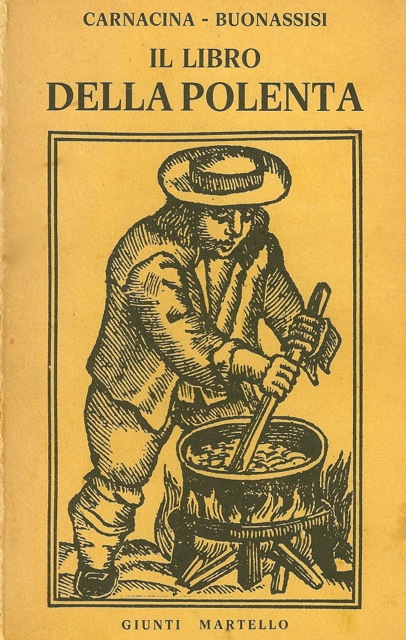
Stirring polenta in a paiolo (cauldron) with a bastone (paddle). Woodcut, first published in a popular Milano (Lombardy) newspaper to illustrate, “The Magnificent Virtues of Polenta,” c. 1860. Bertarelli Collection, Castello Sforzesco, Milano.
Two gastronomes of the last century, Luigi Carnacina and Vincenzo Buonassisi, in their classic, “Il Libro della Polenta,” my first polenta primer, wrote,
Stir, stir, without fear…. You have to continue with that blessed bastone (wooden paddle), at least an extra half hour [we’re up to an hour now]. And do you know why? Because this extra cooking, these additional rotations in the polenta pot — always in the same direction [clockwise], always rhythmic, are never enough — they make the polenta more digestible, more delicious; they take way any slightly bitter flavor that sometimes remains, which only reveals the fret and impatience of whomever has cooked it. After an hour, instead, the polenta is cooked, but if you still carry on with the stirring even longer, with the highest degree of devotion, it will become perfect.”
It is true that the longer one stirs, the better the polenta and that, in fact, one can’t ever stir long enough. I know this because I have stirred for as long as two hours, once, on a quiet day when there were no tasks at hand and no children or husbands to attend to. The resulting porridge was more delicious than any I had ever made. That particular marathon was impelled by the sheer meditative pleasure of watching the soft golden swells undulating in my old copper pot, their vapors filling the room while I stared out at a snow fall from my kitchen window. When I have the luxury of time for such long stirring, I do just that, adding more hot water as necessary, just as Carnacina and Buonassisi instruct, to keep the mass soft and supple as the grains yield their inimitable fragrance and the polenta reaches perfection. But who, among us, in today’s fast world, has such a luxury of time?
Mini-Stirring for Moderns
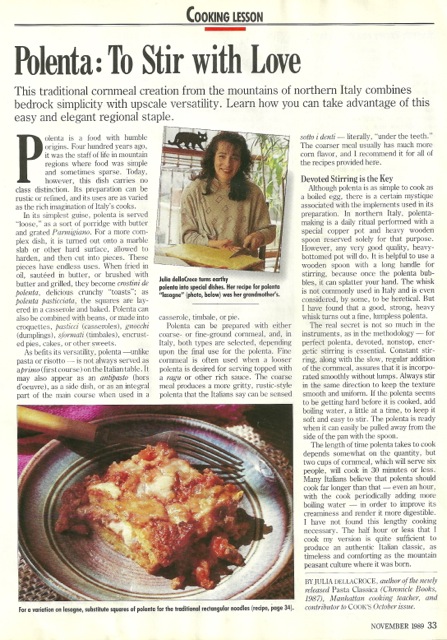 Hence, writing about polenta for Cook’s in the relative early days of the American love affair with genuine Italian cooking, I could, with good conscience, write that one could make a serviceable polenta in forty-five minutes. The Cook’s test kitchen, ever looking for ways of making recipes faster and better, was charmed by the notion that making polenta in the traditional way was still a daily ritual in some parts of Italy. Nevertheless, the editors were determined to find a way to get around having to be stationed at the pot for the good part of an hour. (Since then, quick-cooking polenta has become commonplace, but the flavor and texture of the long-cooking original is superior, so on with this story.)
Hence, writing about polenta for Cook’s in the relative early days of the American love affair with genuine Italian cooking, I could, with good conscience, write that one could make a serviceable polenta in forty-five minutes. The Cook’s test kitchen, ever looking for ways of making recipes faster and better, was charmed by the notion that making polenta in the traditional way was still a daily ritual in some parts of Italy. Nevertheless, the editors were determined to find a way to get around having to be stationed at the pot for the good part of an hour. (Since then, quick-cooking polenta has become commonplace, but the flavor and texture of the long-cooking original is superior, so on with this story.)
My article ran, but Cook’s experimented and came up with a microwave method for cooking it in half the time with barely any stirring, and they published that method along with mine. Several years later, Marcella Hazan, in her book, “Essentials of Italian Cooking,” provided a different recipe, “Polenta by No-Stirring,” which pleasantly surprised me. I recently asked Victor Hazan, the late cookbook author’s husband and collaborator about it, and he explained the derivation of the method (and sent me the vintage photo below):
Marcella had a housekeeper/assistant, Maria, who lived with us in New York and Italy for more than twenty years…. She was from Badoere, a small town in the Veneto. Her cooking repertory was limited and rustic, usually not a fertile source of ideas for Marcella, but one day that Marcella asked her to make polenta for us, she found her making it more or less by the method described in the recipe, which Maria said was the way they did it at home. Marcella was intrigued, and on another occasion, and then another — Marcella never tested anything once — she made it and perfected it herself. “
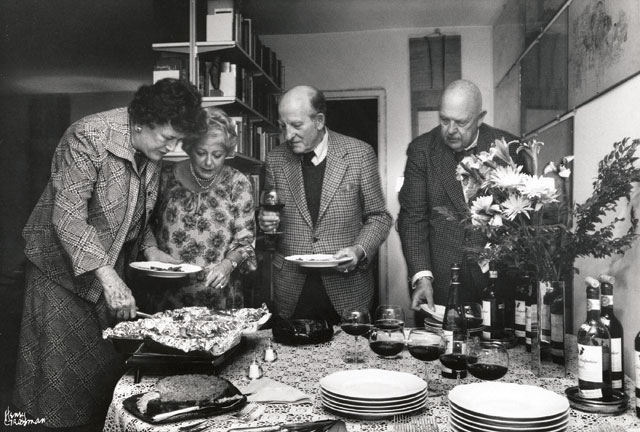
Marcella taught America about Italian food, and how to cook polenta. From left to right, Julia Child, Marcella, Paul Child, James Beard. | Credit: Henry Grossman, Courtesy, Grossman Enterprises
Marcella’s recipe, which she called the “No-Stirring Method” (I have renamed my adaptation of the recipe the “Mini-Stirring Method”) in her aforementioned cookbook, shares principles with the Cook’s method, although the cooking is done on the stovetop, not in a microwave. While long, continuous stirring undoubtedly develops the creaminess of the grains, I have since used both of these methods myself when too many other kitchen tasks need my attention at the same time. The important thing is to avoid the raw taste and gritty feel in the mouth of undercooked cornmeal. Whichever method you use, the old trick of keeping some water simmering on the back burner and stirring in a little in as necessary to thin out the polenta should it thicken too much, still applies. You will know the cornmeal has turned into polenta when the hot mass can be pulled away easily from the sides of the pot with a wooden spoon or wire whisk.
Since this post was first published, a friend, Rosemary Melli, wrote to me about Paula Wolfert’s recipe for oven polenta, a method many restaurant chefs follow, baking it for as long as three hours. Rosemary writes, “I use this one now almost all the time (yes, as TIME is the issue), and the polenta cooks (slowly) for about 1.5 hrs., and it’s perfect every time.” In her Mediterranean Clay Pot Cooking,” Paula writes, “[It’s] a great way to produce perfect polenta without a lot of work, using a well-greased earthenware cazuela. The method described in the recipe coaxes extra flavor from the coarse cornmeal by allowing it to toast as it cooks, resulting in a soft, tender polenta with a lovely glossy sheen.”
Yet another message arrived from cookbook author and caterer, Beth Hensperger of Palo Alto, California. She wrote, “The slow cooker does an admirable, gloriously simple job of a laborious task usually having the cook standing and stirring for an hour.”
Here are my adaptations of all four mini-stir methods. Note that for successful results, the quantities of ingredients called for should not be scaled down in any of the recipes. And about substituting instant polenta for the long-cooking variety, stay tuned.
Microwave Polenta
This recipe is suitable for the traditional, long-cooking variety of Italian cornmeal polenta, whether fine- or coarse-grained. It is not appropriate for quick-cooking polenta.
Prep Time: 3 minutes
Cooking Time: 24 minutes
Total Time: about 30 minutes
Yield: about 8 cups cooked polenta
Ingredients:
8 cups water
1 tablespoon fine sea salt
2 cups fine- or coarse-grained imported Italian polenta cornmeal (I use only non-GMO or organic)
Directions:
In a 4-quart microwave-safe bowl with tight fitting cover, whisk together the water, salt, and cornmeal. Cover completely and cook at full power in a microwave for 24 minutes in total, removing the cover to stir thoroughly, then replacing the lid, every 6 minutes. The polenta should be thick and creamy, and pull cleanly away from the sides of the bowl easily when it is done. Serve it loose immediately or turn it out onto your work surface to set according to the recipe of your choice.
Polenta by the Mini-Stirring Method
This recipe is suitable for the traditional, long-cooking variety of Italian cornmeal polenta, whether fine- or coarse-grained. It is not appropriate for quick-cooking polenta.
Prep Time: 5 minutes
Cooking Time: about 90 minutes
Total Time: about 1-1/2 hours
Yield: about 8 cups cooked polenta
Ingredients:
water
1 tablespoon fine sea salt
2 cups fine- or coarse-grained imported Italian yellow or white polenta cornmeal
Directions:
- Bring 9 cups water to a boil in an ample, deep, heavy-bottomed pot with a tight-fitting lid. Have a separate pot or kettle filled with about 4 cups of boiling hot water at the ready on the back burner. Add the salt to the polenta cooking pot.
- Using a large, heavy whisk, or a long-handled wooden spoon, stir in the cornmeal in a slow, constant stream to prevent lumps from forming without breaking the boil. Keep the cornmeal simmering over medium heat for 2 minutes, stirring continually. Cover the pot firmly and continue cooking without breaking the boil, at medium to medium-low heat for 10 minutes. Uncover and stir well. Repeat simmering for 10 minutes, uncovering the pot and stirring, then replacing the cover, two more times, adding a cup or so of additional boiling water from the secondary pot, or kettle, if the mush appears too thick. Continue to simmer, uncovered, until the polenta comes away from the sides of the pot easily when stirred, 5-10 more minutes more, pouring in more of the reserved hot water as necessary to loosen it up if it appears too thin. If it appears too thick, stir in additional boiling hot water; if it seems too thin, let it simmer a little longer to thicken. It is done when the polenta pulls away easily from the sides of the pot with a whisk or wooden spoon. When it is done, stir with a long wooden spoon from bottom to top, reaching into the sides of the pan to unstick the mass from the bottom corners of the pan. It is ready to be turned out to a serving bowl or oiled counter surface, depending on your recipe.
Paula Wolfert’s Oven Polenta in a Clay Pot
I asked Paula about the origins of this recipe, and she wrote, “It’s a recipe that’s been around for a long time…. I found it on the back of bags of Golden Pheasant polenta, a very good artisanal brand out of San Francisco. I called the owner for story and permission, he said he’d learned it years before from a friend’s mom.”
Prep Time: 5 minutes
Cooking Time: about 55 minutes
Total Time: about 1 hour
Yield: about 8 cups cooked polenta
Ingredients:
2 cups imported medium- or coarse -grained organic stone-ground polenta cornmeal
2 tablespoons unsalted butter or extra-virgin olive oil
2 teaspoons fine sea salt
Equipment: Paula prefers a 12-inch Spanish cazuela (clay pot); other oven-proof ceramic baking dishes can be substituted
Directions:
- Preheat an oven to 350 degrees F. In the cazuela, stir together the cornmeal, 8-10 cups cool water, the butter, and the salt. Bake, uncovered, for 1 hour and 20 minutes.
- Stir the polenta and bake for 10 minutes longer.
- Remove the cazuela from the oven and set on a wooden surface or folded kitchen towel to prevent cracking. Let the polenta rest for 5 minutes before spooning it into a buttered bowl. Serve hot.
Paula’s note: The consistency of the polenta is a factor in deciding how much liquid to use. For soft polenta, use 5 parts liquid to 1 part cornmeal and for firm polenta, 4 parts liquid to 1 part cornmeal.
Not Your Mother’s Slow Cooker Polenta
Machine: Medium or Large Round or Oval
Machine Setting and Cook Time: High Heat: 30 minutes to 1 hour, then Low Heat: about 5 hours
Prep Time: 5 minutes
Yield: about 8 cups cooked polentaIngredients:
1 1/2 cups medium- or coarse-grain yellow polenta
1 1/2 teaspoons salt (I like one of the sea salts)
Fresh ground black pepper, to taste
8 tablespoons (1 stick) butter
1 cup grated or shredded Parmesan or Italian fontina cheese
Directions:
- Place the water, polenta, and salt in the cooker. With a whisk, stir for a few seconds. Cover and cook on HIGH for 30 minutes to 1 hour to heat the water. Stir again and set for LOW to cook for about 5 hours, stirring occasionally with a wooden spoon. The polenta will thicken quite quickly after 2 hours, sort of expand magically in the cooker and look done, but it will need the extra time to cook all the grains evenly.
- At 5 hours, taste and make sure the desired consistency has been reached and all the grains are cooked tender. The longer the polenta cooks, the creamier it will become. When done, it will be smooth, very thick, yet pourable, and a wooden spoon will stand up by itself without falling over (the true test).3. Polenta will be fine left on the KEEP WARM or LOW setting for an hour, if necessary, adding a bit more hot water if it gets too stiff. Stir before serving, immediately, in any of the following ways.
Tips for Serving Loose Polenta
- Stir in butter and top with grated or shaved grand padano, parmigiano, or shredded fontina cheese.
- Drizzle with good olive oil.
- Eat with with paper-thin slices of imported Italian prosciutto, coppa, or good artisanal finocchiona, or other artisan salami on the side.
- Slather it generously with a runny cheese of your choice, such as taleggio.
- Serve it on a wide, shallow platter topped with braised or sautéed greens, whether broccoletti (broccoli rabe), kale, mustard greens, or collards.
- Use it as a bed for fried eggs or uova affogate (eggs “drowned” [poached] in tomato sauce) — or anything else cooked in tomato sauce (polenta and tomato is a marriage made in heaven).
- Make a “well” in the center to cradle braised or roasted meats, or seafood.
Some Other Uses for Polenta
- Pour out the polenta onto a marble board, or into a greased shallow baking pan or loaf pans to cool; it will stiffen, yet be quite tender. Refrigerate, covered, if not using within a few hours. Then you can fry the slices or squares in butter or olive oil and serve alongside roasted meats or egg dishes.
- Cut into pieces for polenta “pasticciata,” arranged into layers between a sauce such as for a baked lasagna.
- Brush with olive oil and grill it until charred on both sides.
With thanks to Victor Hazan, Cook’s magazine, Paula Wolfert, and Beth Hensperger.

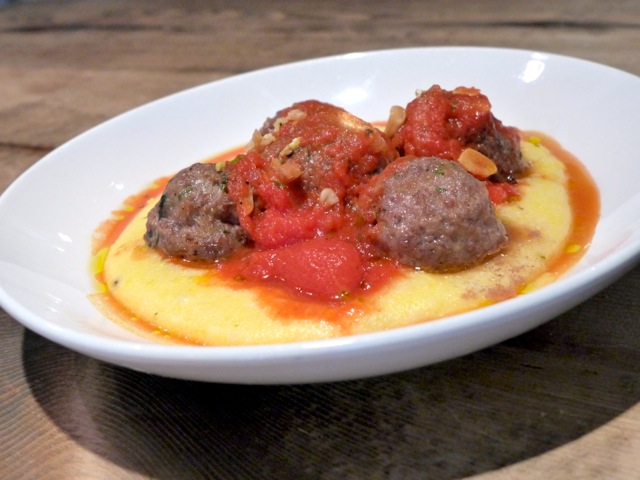
 Follow
Follow
 email
email
Such a wonderful piece Julia, and so right for the winter season! However I’m sure you also know about the oven method for cooking polenta, especially the one proposed by Paula Wolfert in “The Slow Mediterranean Kitchen”. I use this one now almost all the time (yes, as TIME is the issue), and the polenta cooks (slowly) for about 1.5 hrs.; and it’s perfecto every time.
Yesterday I made the traditional ‘brodo’, as I learned it from the Clemente Family in Manfredonia in Puglia. It took all day but was definitely wonderful. I’d love for you to do a piece on brodo sometime. I’m sure there are many versions.
xo
Since you wrote, I have included Paula’s method. Thanks so much. The internet is a wonderful thing, isn’t it? It took no longer than an hour to find it and re-publish the post! Remember the analog days when you had to wait weeks sometimes to publish an update to a newspaper article?
What a great post Julia! I have been, for some time, using Marcella’s recipe and like it a lot…one thing I did not know about was adding simmering water to have the right consistency! I have microwaved polenta too and it’s fine but agree that the longer the better…I will try Paula’s method…anything to make things simpler while doing other tasks is a bonus, especially if it tastes great!
I’ve always loved all the stirring, as I admitted, but any of the methods are improved by long cooking. Keep me posted about any of your polenta adventures!
These methods are wonderful, but I prefer stirring. I loved reading your description of the time that you stirred for two hours. I should find some way to read while I stir.
That makes two of us, dear Bob.
You are the great teacher as usual. Some history, experience, many methods to choose. Nothing is written in stone. These techniques are great for grits too.
Yes, we can apply them to grits, which are no different from polenta except that they are ground from dried hominy (alkaline-processed, or nixtamalized corn) rather than dried corn. Everything does change. The art is in figuring out how not to throw out the baby with the bathwater.